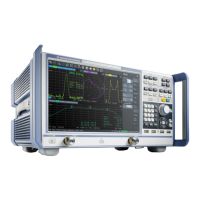Concepts and Features
R&S
®
ZNB/ZNBT
89User Manual 1173.9163.02 ─ 55
If on the other hand the swept mode is not used although it was selected, the underly-
ing reason is displayed in an information popup:
●
The specifications of the data sheet are stated for stepped mode; in swept mode
they are not guaranteed
●
Compared to stepped mode the trace noise in swept mode is generally higher
●
DUTs with long group delay cannot be measured correctly in swept mode
●
It is essential to perform the Calibration with the same stepped/swept mode set-
tings as for the actual measurement; otherwise the calibration is turned off (see
"Cal Off label" on page 148)
5.1.5 Data Flow
The analyzer processes the raw measurement data in a sequence of stages to obtain
the displayed trace. The following diagram gives an overview.
The diagram consists of an upper and a lower part, corresponding to the data process-
ing stages for the entire channel and for the individual traces. All stages in the diagram
are configurable. Note that the channel data flow for S-parameters (and quantities
derived from S-parameters such as impedances, admittances, stability factors) differs
from the channel data flow for wave quantities (and derived quantities such as ratios).
Basic Concepts

